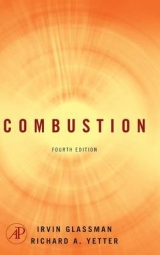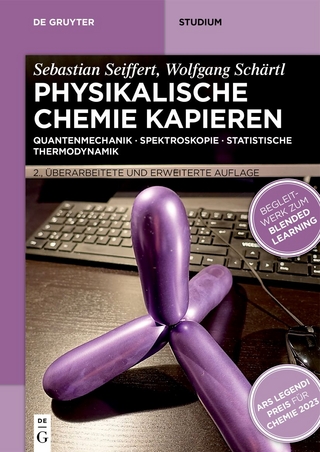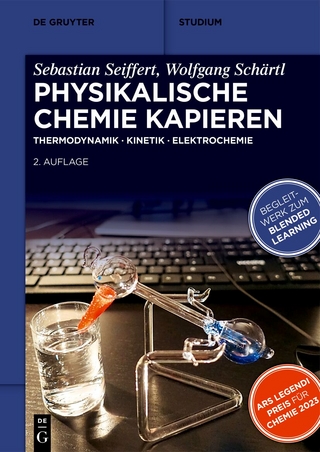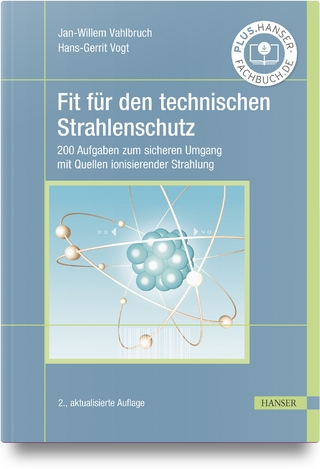
Combustion
Academic Press Inc (Verlag)
978-0-12-285852-9 (ISBN)
- Titel erscheint in neuer Auflage
- Artikel merken
This Third Edition of Glassman's classic text clearly defines the role of chemistry, physics, and fluid mechanics as applied to the complex topic of combustion. Glassman's insightful introductory text emphasizes underlying physical and chemical principles, and encompasses engine technology, fire safety, materials synthesis, detonation phenomena, hydrocarbon fuel oxidation mechanisms, and environmental considerations. "Combustion" has been rewritten to integrate the text, figures, and appendixes, detailing available combustion codes, making it not only an excellent introductory text but also an important reference source for professionals in the field. It explains complex combustion phenomena with physical insight rather than extensive mathematics. It clarifies postulates in the text using extensive computational results in figures; lists modern combustion programs indicating usage and availability; and relates combustion concepts to practical applications.
Dr. Irvin Glassman received both his undergraduate and graduate degrees in Chemical Engineering from The Johns Hopkins University. In 1950 he joined Princeton University, and is currently Robert H. Goddard Professor of Mechanical and Aerospace Engineering. He has also been American Cyanamid Professor of Envirionmental Sciences and Director of Princeton's Center for Energy and Evironmental Studies. For 15years Dr. Glassman represented the United States as a member (and former chairman) of the Propulsion and Energetics Panel of AGARD/NATO. He has been a member of numerous committees, task forces, and research teams, and is currently a member of The National Academy of Engineering and many other professional and honorary societies. Dr. Glassman is listed in Who's Who in America, Who's Who in the World, Outstanding Educators of America, and American Men of Science.
Chemical Thermodynamics and Flame Temperatures: Introduction. Heats of Reaction and Formation. Free Energy and the Equilibrium Constants. Flame Temperature Calculations. Analysis. Practical Considerations. Problems. References. Chemical Kinetics: Introduction. The Rates of Reactions and Their Temperature Dependency. The Arrhenius Rate Expression. Transition State and Recombination Rate Theories. Simultaneous Interdependent Reactions. Chain Reactions. Pseudo-First-Order Reactions and the"Fall-Off"Range. The Partial Equilibrium Assumption. Pressure Effect in Fractional Conversion. Problems. References. Explosive and General Oxidative Characteristics of Fuels: Introduction. Chain Branching Reactions and Criteria for Explosion. Explosion Limits and Oxidation Characteristics of Hydrogen. Explosion Limits and Oxidation Characteristics of Carbon Monoxide. Explosion Limits and Oxidation Characteristics of Hydrocarbons. Organic Nomenclature. Explosion Limits."Low-Temperature"Hydrocarbon Oxidation Mechanisms. The Oxidation of Aldehydes. The Oxidation of Methane. Low Temperature Mechanism. High Temperature Mechanism. The Oxidation of Higher Order Hydrocarbons. Aliphatic Hydrocarbons. Alcohols. Aromatic Hydrocarbons.Problems. References. Flame Phenomena in Premixed Combustible Gases: Introduction. Laminar Flame Structure. The Laminar Flame Speed. The Theory of Mallard And Le Chatelier. Comprehensive Theory And Laminar Flame Structure Analysis. The Laminar Flameand The Energy Equation. Flame Speed Measurements. Experimental Results--Physical and Chemical Effects. Stability Limits of Laminar Flames. Flammability Limits. Quenching Distance. Flame Stabilization (Low Velocity). Stability Limits and Design. Turbulent Reacting Flows and Turbulent Flames. The Rate of Reaction in a Turbulent Field. Regimes of Turbulent Reacting Flows. The Turbulent Flame Speed. Stirred Reactor Theory. Flame Stabilization in High-Velocity Streams. Problems. References. Detonation:Introduction. Premixed and Diffusion Flames. Explosion, Deflagration, and Detonation. The Onset of Detonation. Detonation Phenomena. Hugoniot Relations and the Hydrodynamic Theory of Detonations. Characterization of the Hugoniot Curve and the Uniquenessof the Chapman Jouguet Point. Determination of the Speed of Sound in the Burned Gases for Conditions Above the Chapman Jouguet Point. Calculation of the Detonation Velocity. Comparison of Detonation Velocity Calculations with Experimental Results. The Structure of the Cellular Detonation Front and Other Detonation Phenomena Parameters. The Cellular Detonation Front. The Dynamic Detonation Parameters. Detonation Limits. Detonations in Non-Gaseous Media. Problems. References. Diffusion Flames: Introduction. Gaseous Fuel Jets. Appearance. Structure. Theoretical Considerations. The Burke Schumann Development. Turbulent Fuel Jets. Burning of Condensed Phases. General Mass Burning Considerations and the Evaporation Coefficient. Single FuelDroplets in Quiescent Atmospheres. Burning of Droplet Clouds. Burning in Convective Atmospheres. The Stagnant Film Case. The Longitudinally Burning Surface. The Flowing Droplet Case. Burning Rates of Plastics; The Small B Assumption And Radiation Effects.Problems. References. Ignition: Concepts. Chain Spontaneous Ignition. Thermal Spontaneous Ignition. Semenov Approach to Thermal Ignition. Frank Kamenetskii Theory of Thermal Ignition. Forced Ignition. Spark Ignition and Minimum Ignition Energy. Ignition by Adiabatic Compression and Shock Waves. Problems. References. Environmental Combustion Considerations: Introduction. The Nature of Photochemical Smog. Primary and Secondary Pollutants. The Effect of NoX. The Effect of SoX. Formation and Reduction of Nitrogen Oxides. The Structure of the Nitrogen Oxide. The Effect of Flame Structure. Reaction Mechanisms of Oxides of Nitrogen. SOX Emissions. The Product Composition and Structure of Sulfur Compounds. Oxidative Mechanisms of Sulfur Fuels. Particulate Formation. Characteristics of Soot. Soot Formation Processes. Experimental Systems and Soot Formation. Sooting Tendencies. Detailed Structure of Sooting Flames. Chemical Mechanisms of Soot Formation. The Influence of Physical and Chemical Parameters on Soot Formation. Stratospheric Ozone. The HOX Catalytic Cycle. The NOX Catalytic Cycle. The CIOX Catalytic Cycle. Problems. References. Combustion of Nonvolatile Fuels: CarbonChar, Soot and Metal Combustion. Metal Combustion Thermodynamics. The Criterion for Vapor Phase Combustion. Thermodynamics of Metal-Oxygen Systems. Thermodynamics of Metal-Air Systems. Combustion Synthesis. Diffusional Kinetics. Diffusion Controlled Burning Rate. Burning of Metals in Nearly Pure Oxygen. The Burning of Carbon Char Particles. The Burning of Boron Particles. Oxidation of Very Small Particles--Pulverized Coal and Soot. The Burning of Porous Chars. The Burning Rate of Ash-Forming Coal. Problems. References. Appendixes. Index.
| Erscheint lt. Verlag | 8.1.1997 |
|---|---|
| Zusatzinfo | b&w illustrations |
| Verlagsort | San Diego |
| Sprache | englisch |
| Maße | 152 x 229 mm |
| Gewicht | 1044 g |
| Themenwelt | Naturwissenschaften ► Chemie ► Physikalische Chemie |
| Naturwissenschaften ► Physik / Astronomie ► Strömungsmechanik | |
| ISBN-10 | 0-12-285852-2 / 0122858522 |
| ISBN-13 | 978-0-12-285852-9 / 9780122858529 |
| Zustand | Neuware |
| Informationen gemäß Produktsicherheitsverordnung (GPSR) | |
| Haben Sie eine Frage zum Produkt? |
aus dem Bereich



